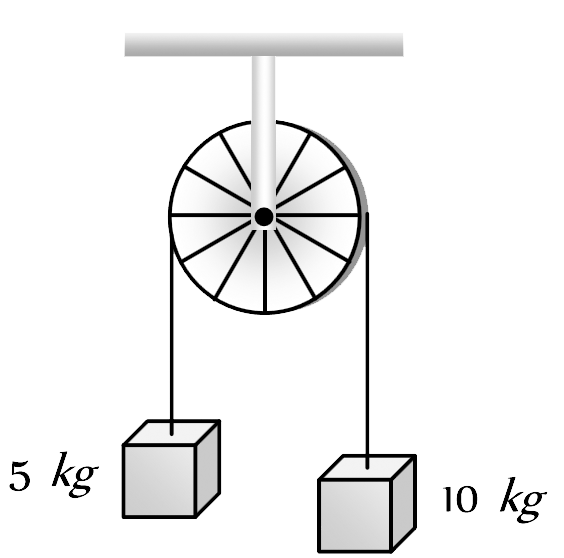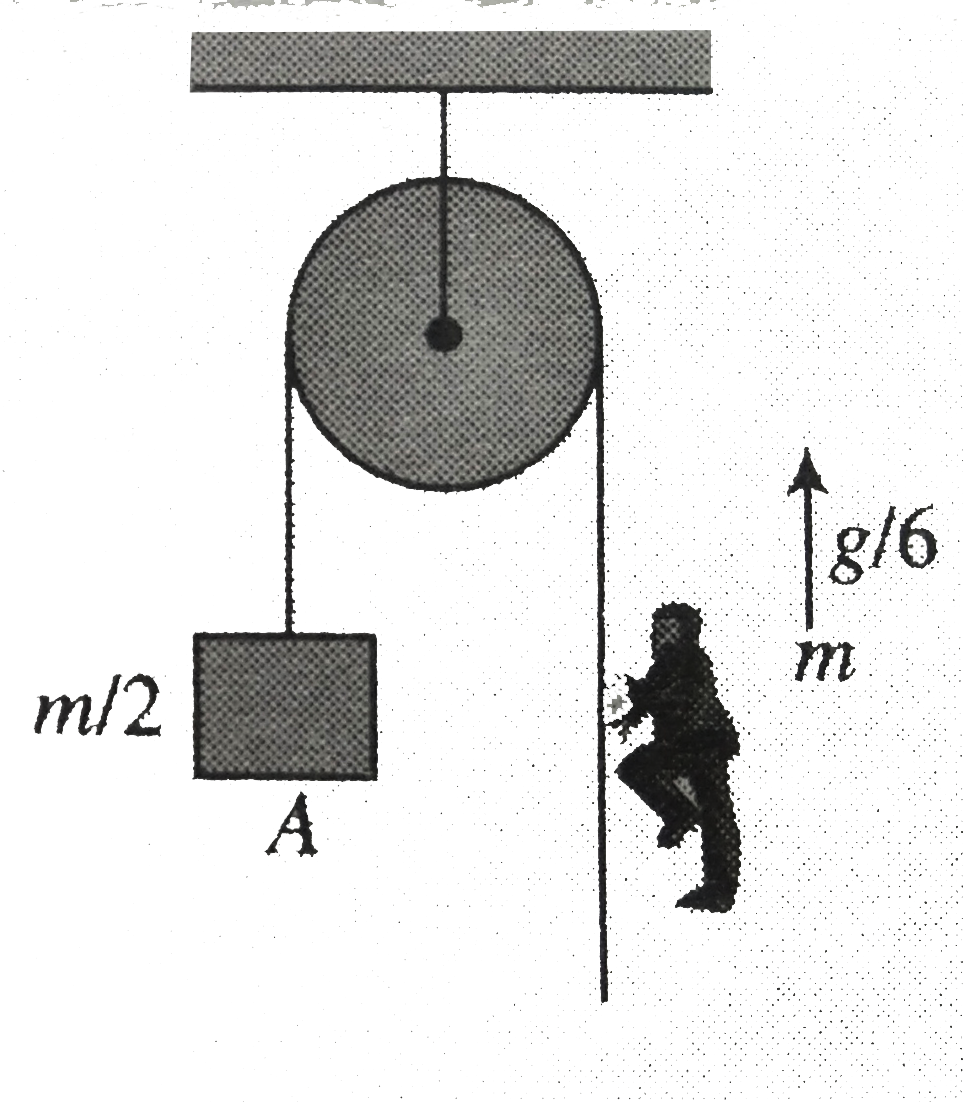A man of mass m stands on a frame of mass M. He pulls on a light rope, which passes over a pulley. The other end of the rope is attached to the frame. For the system to be in equilibrium, what force must the man exert on the rope?
 Solution in Gujrati
Solution in Gujrati
For system to be in equilibrium
2T=(M+m)g
T=(M+m)g2

Topper's Solved these Questions
- NEWTONS LAWS OF MOTIONBOOK - ALLEN CHAPTER - NEWTONS LAWS OF MOTIONEXERCISE - EXERCISE-I
52 Videos
- NEWTONS LAWS OF MOTIONBOOK - ALLEN CHAPTER - NEWTONS LAWS OF MOTIONEXERCISE - EXERCISE-II
112 Videos
- NEWTONS LAWS OF MOTIONBOOK - ALLEN CHAPTER - NEWTONS LAWS OF MOTIONEXERCISE - EXERCISE-III
28 Videos
- NEWTON'S LAWS OF MOTION & FRICTIONBOOK - ALLEN CHAPTER - NEWTON'S LAWS OF MOTION & FRICTIONEXERCISE - EXERCISE (JA)
4 Videos
- RACEBOOK - ALLEN CHAPTER - RACEEXERCISE - Basic Maths (Wave Motion & Dopplers Effect) (Stationary waves & doppler effect, beats)
25 Videos
Similar Questions
USS 150) Two masses of 5 kg and 10 kg are connected to a pulley as shown. What will be the acceleration of the system (g= acceleration due to gravity)

View SolutionA particle is in straight line motion with uniform velocity A force is not required
View SolutionAssertion: The driver in a vechicle moving with a constant speed on a straight road is in a non-inertial frame of referance.
Reason: A reference frame in which Newton's laws of motion are applicable is non-inertial.
View SolutionA piece of wire is bent in the shape of a parabola y=kx2 (y-axis vertical) with a bead of mass m on it. The bead can slide on the wire without friction. It stays at the lowest point of the parabola when the wire is at rest. The wire is now accelerated parallel to the x-axis with a constant acceleration a. The distance of the new equilibrium position of the bead, where the bead can stay at rest with respect to the wire, from the y-axis is:
View SolutionThe frequency of a radar is 780 MHz. After getting reflected from an approaching aeroplane, the apparent frequency is more than the actual frequency by 2.6 kHz. The aeroplane has a speed of
View SolutionBlock A of mass m/2 is connected to one end of light rope which passes over a pulley as shown in fig. A man of mass m climbs the other end of rope with a relative acceleration of g/6 with respect to rope. Find the acceleration of block A and tension in the rope.

View SolutionIn the given diagram, with what force must the man pull the rope to hold the plank in position? Mass of the man is 80kg. Neglect the weights of plank, rope and pulley. Take.

View SolutionA rope thrown over a pulley has a ladder with a man of mass m on one of its ends and a counter balancing mass M on its other end. The man climbs with a velocity vr relative to ladder. Ignoring the masses of the pulley and the rope as well as the friction on the pulley axis, the velocity of the centre of mass of this system is:
View SolutionA cart of mass M is tied to one end of a massless rope of length 10m. The other end of the rope is in the hands of a man of mass M. The entire system is on a smooth horizontal surface. The man is at x=0 and the cart at x=10m. If the man pulls the cart by the rope, the man and the cart will meet at the point
View SolutionA man of mass M stands on a.box of mass m as shown in the Fig. 2E. l (a). A rope attached to 'the box and passing over an overhead pulley allows the man to raise himself and the box by , pulling the rope downward. (i) With what minimum force should the ' man pull the rope so as to prevent himself , from falling down. (ii) If the man pulls the rope with a force F greater than the minimum force, then determine the acceleration of the (man + box) system. (iii) Determine. the normal reaction between the man and the trolley.
View SolutionA block of mass M is attached to the lower end of a vertical rope of mass m. An upward force P acts on the upper end of the rope. The system is free to move. The force exerted by the rope on the block is PMM+m
View SolutionA man sits in a chair that is suspended from arope. The rope passes over a pulley suspended from the ceiling, and the man holds the other end of the rope in his hands.What is the tension in the rope, and what force does the chair exert on the man ?
View SolutionA mam of mass 50 g stands on a frame of mass 30 g. He pulls on a light rope which passes over a pulley. The other end of the rope is attached to the frame. For the system to be in equilibrium what force man must exert on the rope?
View SolutionAt one end of a weightless rope of length 10 m, a car of mass M is tied. The other end of the rope is in the hands of a man of mass M. The arrangement stands on a horizontal frictionless surface. The man is at x=0 and the car is at x =10 m. As the man pulls the car with the rope locate the point where they meet.
View SolutionThe mass of a lump M is pulled by a rope of mass m over a horizontal non-abrasive surface. The key is activated at the non-loaded end of the rope. What is the force exerted by the rope on the tumor?
View SolutionA rope thrown over a pulley has ladder (of mass M - m) with a man of mass m on one of its ends and a counterbalancing mass M on its other end The man climbs with a velocity vr relative to a ladder. Pulley and rope are ideal. The velocity of centre of mass of the system is
View Solution
